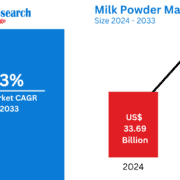GCC Foodservice Market : Key Drivers, Regional Insights & Forecast to 2033
GCC Foodservice Market: Growth Trends and Forecast (2025-2033)
Introduction
The GCC (Gulf Cooperation Council) foodservice industry is experiencing rapid growth, with projections indicating it will reach US$ 158.22 billion by 2033, up from US$ 51.84 billion in 2024. The sector is growing at a compound annual growth rate (CAGR) of 13.25% from 2025 to 2033. Several factors are contributing to this expansion, including the region’s growing tourism, urbanization, shifting consumer preferences towards convenience and health-conscious dining, advancements in technology, and a burgeoning food delivery market.
Market Overview
The GCC foodservice market encompasses a wide range of sectors, from quick-service restaurants (QSRs) to full-service restaurants, cafes & bars, and cloud kitchens. A wide variety of cuisines is gaining popularity across the GCC, particularly due to the region’s cultural diversity and the growing demand for both traditional Middle Eastern foods and international flavors. As the demand for culinary experiences increases, the sector is seeing a rise in fusion restaurants, cloud kitchens, and digital ordering platforms that are reshaping customer engagement.
Key Growth Drivers
- Population Growth and Urbanization
The growing urban population and the increasing number of expatriates are driving demand for diverse foodservice options in the GCC. As urban centers expand, both the availability and demand for foodservice outlets increase, fostering an environment ripe for innovation and diverse dining experiences. - Rising Disposable Incomes
As the middle class in the GCC becomes wealthier, consumer dining habits are shifting. There is an increased preference for fine dining, gourmet experiences, and specialty foods. This shift is not limited to in-store dining but extends to food delivery services, further boosting the foodservice market. - Tourism Boom
The tourism sector is one of the main contributors to the expansion of the foodservice industry in the GCC. With major events like Expo 2020 Dubai and various athletic competitions, there is a significant demand for foodservice providers that cater to both tourists and locals. International food chains are increasingly setting up shop in the region to tap into the growing demand.
Challenges Facing the GCC Foodservice Market
- Sustainability and Waste Management
Environmental concerns are becoming more pronounced, and the foodservice industry is under pressure to implement sustainable practices. Waste management, sustainable food sourcing, and eco-friendly packaging are essential in ensuring long-term growth. However, these practices often come with higher operational costs and require careful planning and investment. - Fluctuating Food Prices
The GCC’s heavy reliance on food imports makes the region vulnerable to fluctuations in global food prices. Factors such as geopolitical tensions, natural disasters, or trade policies can result in price volatility, making it difficult for foodservice operators to maintain stable margins. As a result, operators must remain agile, adjusting prices or absorbing higher costs where necessary.
Related Report
- GCC Hydroponics Market Size and Share Analysis – Growth Trends and Forecast Report 2025-2033
- GCC Halal Food and Beverage Market, Size, Forecast 2023-2027, Industry Trends, Growth, Share, Outlook, Impact of Inflation, Opportunity Company Analysis
- GCC Smart Home Market Size and Share Analysis – Growth Trends and Forecast Report 2025-2033
Regional Market Overview
- United Arab Emirates (UAE)
The UAE, particularly cities like Dubai and Abu Dhabi, serves as a hub for foodservice due to its high population density, large expatriate community, and thriving tourism sector. The market is seeing a rise in demand for various dining options, from fast food to fine dining. The UAE’s commitment to sustainability and health-conscious eating has further increased the demand for eco-friendly and healthier dining options. - Saudi Arabia
Saudi Arabia’s foodservice market is flourishing thanks to a young population, increased urbanization, and higher disposable incomes. The nation’s Vision 2030 project, aimed at diversifying the economy, has brought significant investments into the foodservice sector. Consumers are increasingly seeking healthier, sustainable options, which is shaping the future of the market. - Bahrain
Bahrain’s foodservice industry is steadily expanding, with a particular focus on catering to both the local population and the growing number of tourists, especially during events like the Formula 1 races. The growing middle class and rising disposable incomes are driving demand for various dining options, including healthy and sustainable food offerings. - Kuwait
The foodservice industry in Kuwait is being driven by its youthful urban population and growing preference for convenience and quick-service dining. There is a notable shift towards health-conscious eating and sustainable dining practices, with increased demand for organic and locally sourced ingredients.
Foodservice Market Segmentation
The GCC foodservice market is segmented by the following factors:
- Foodservice Type: Cafes & Bars, Cloud Kitchen, Full-Service Restaurants, Quick Service Restaurants
- Outlet Type: Chained Outlets, Independent Outlets
- Location Type: Leisure, Lodging, Retail, Standalone, Travel
- Countries: Bahrain, Kuwait, Oman, Qatar, Saudi Arabia, United Arab Emirates, Rest of GCC
Company Analysis
Several companies are making a significant impact in the GCC foodservice market, including:
- Al Tazaj Fakeih
- Alamar Foods Company
- ALBAIK Food Systems Company SA
- Galadari Ice Cream Co. Ltd LLC
- Herfy Food Service Company
- Kudu Company For Food And Catering
- LuLu Group International
- Riyadh International Catering Corporation
- Shahia Food Limited Company
Key Questions for Analysis
- What is the current size of the GCC foodservice market and what are the growth projections for 2025-2033?
- What are the major factors driving the growth of the foodservice industry in the GCC region?
- How has tourism influenced the expansion of the GCC foodservice sector?
- What challenges do foodservice operators face in the GCC, particularly regarding sustainability and fluctuating food prices?
- How are consumer preferences evolving in the GCC, and what role does technology play in shaping dining experiences?
- Which countries within the GCC are showing the most significant growth in foodservice demand?
- What is the impact of urbanization on the foodservice market in the GCC?
- How does disposable income affect the types of dining experiences consumers seek in the GCC?
- What are the future trends in the GCC foodservice market, particularly with regards to health-conscious dining and sustainability?
- How are major players like ALBAIK and Herfy shaping the future of the foodservice industry in the region?
Conclusion
The GCC foodservice market is set for continued growth driven by increasing urbanization, tourism, and changing consumer preferences. As the market matures, the key focus will be on sustainability, health-conscious options, and technological advancements such as cloud kitchens and digital platforms. With opportunities for innovation, the GCC remains an attractive region for foodservice operators and international brands looking to expand their reach.
For further insights and a more detailed analysis, please contact Renub Research or request a customized report tailored to your needs.










